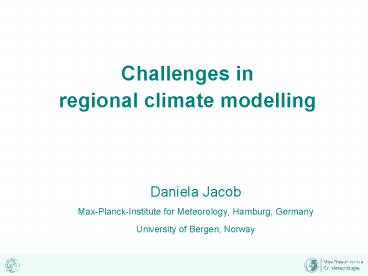Challenges in regional climate modelling - PowerPoint PPT Presentation
1 / 33
Title:
Challenges in regional climate modelling
Description:
Abweichung der Tagesmitteltemperatur 2003 vom langj hrigen Mittel (1876-2000 ) in Karlsruhe ... Land sea/lake breezes, orography (eg. Ethiopian highlands, Andes) ... – PowerPoint PPT presentation
Number of Views:61
Avg rating:3.0/5.0
Title: Challenges in regional climate modelling
1
Challenges in regional climate modelling
- Daniela Jacob
- Max-Planck-Institute for Meteorology, Hamburg,
Germany - University of Bergen, Norway
2
Summer 2003 Heat wave in Europa
source Nasa Goddard Institute for Space Studies
Inst. f. Meteorologie und Klimaforschung, Univ.
Karlsruhe
3
IPCC Temperature change
Ensemble mean
C
Standard dev.
C
4
Precipitation change
Ensemble mean
mm/d
Standard dev.
mm/d
5
Outline
- High resolution
- GCM-RCM
- Feedbacks and Interaction
- Conclusions
6
(No Transcript)
7
(No Transcript)
8
Preliminary results
9
Total annual Precipitation
Observations ETH Zürich (1971-90)
10
Outline
- High resolution
- GCM-RCM
- Feedbacks and Interaction
- Conclusions
11
Concept of regional climate change simulations
Emission scenarios (IPCC)
Global Climate Change Scenarios (GCMs)
Regional Climate Change Scenarios (RCMs)
Regional climate change signals
12
Precipitation changes (A1B), 2050
Winter
Spring
Summer
Fall
Where is the 0 change band located?
13
(No Transcript)
14
PRUDENCE Signal in Precipitation 2071-2100
minus 1961-1990, A2
Are these pattern robust? Trend reversal GCM vs
RCM?
15
RT2B1 GCM-RCM Matrix (as off March 2009)
non-contractual runs affiliated
partners without obligations 3 simulations
with the perturbed physics METO-HC GCM
16
precipitation (mm/a) Mid Europe (preliminary)
Why are we overestimating precip? Do we see a
trend?
Quelle Quick Look Analysis, ENSEMBLES Projekt,
www.ensembles-eu.org
17
Precipitation (mm/a) Alps (preliminary)
Where are the differences coming from? Systematic
behavior GCM/RCM?
Quelle Quick Look Analysis, ENSEMBLES Projekt,
www.ensembles-eu.org
18
CLAVIER model ensemble
Analysis for Hungary climate change signal in
precipitation (2021-2050) - (1961-1990)
How does the annual cycle of the signal look like?
19
Extreme Events in the A1B Scenario
1961-1990
2061-2090
Is this a robust feature?
20
Outline
- High resolution
- GCM-RCM
- Feedbacks and Interactions
- Conclusions
21
A1B
C20
no water stress
no water stress
water stress
water stress
Role of regional feedbacks?
22
WCRP-RCM workshop Lund
21st Century Challenges in Regional-scale Climate
Modelling
- Session 1 "Dynamical Downscaling
- Session 2 "New Developments in Numerics and
Physical Parameterisations - Session 3 "From Weather to Climate
- Session 4 "Regional Observational Data and
Reanalysis - Session 5 "Results from Large Projects
- Session 6 "The Future of RCMs (coupled models)
- Session 7 "Impact Studies"
Visions/strategies for reg. Climate modelling?
? Workshop in winter 2009!
23
Scale interactionsandCan we improve the
performance of GCMs in individual regions using
RCMs?
24
Overall Performance Index courtesy Thomas
Reichler Junsu Kim, Univ. of Utah
A combined measure of how well 21 different
global climate models simulate35 different
observed climate features (time averaged, large
scale quantities). Normalized so that the
average model score 1.0 Values less than 1.0
are better.Lower Values Smaller Errors (i.e.,
greater agreement btwn the model simulation
observations)
Avg. of 21models 1.0
25
Climate Elements
Physics (12)
Oceans (9)
Land (1)
Dynamics (9)
25
26
Average Model Performance
Tropics generally less well (50) simulated
than extratropics (-20 to -50) India and Tibet
most problematic (100) courtesy Thomas
Reichler Junsu Kim, Univ. of Utah
27
Circulation of Africa
Dotted lines ITCZ
(Source Nicholson, 2000)
28
WAM Conceptual model
Taken from Paolo M Ruti
29
West African Climate Squall Line
After A.Fink
30
Bimodal precipitation regime in West Africa
Mean over 30 year period (1961 - 90)
REMO
mm/month
GPCC
mm/month
Skill through high resolution?
31
Regional Features in Claris-LPB and AMMA case
studies
- (Some) dynamical flow features in the regions
- ITCZ, SACZ
- Subtropical highs
- Trades/monsoons (WAM)
- Jet streams (AEJ, LLJ)
- Mesoscale convective systems (MCS)
- Regional/local characteristics
- Land sea/lake breezes, orography (eg. Ethiopian
highlands, Andes) - Studies of interactions of large scale flows with
convective systems using high resolution models
are part of AMMA and Claris-LPB (RCM) - High resolution for oceans and along the coasts
are also needed (coupled AORCM)
32
Conclusions
- RCMs are powerful tools to address CC
- RCMs cover transient runs from 1950 to 2100
- Dynamical downscaling opens possibilities for
feedback processes to influence the CC signal - RCMs approach 10 km grids
- many regional details for applications
33
- Questions
- What are the underlying physical processes?
- Interplay with large scale atmospheric dynamics?
- Are the regional climate change signals robust?
humidity transport kg/m2h































